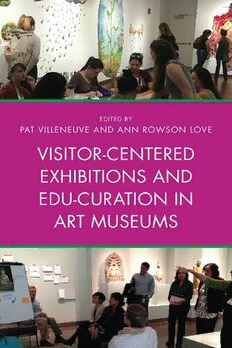
Visitor-Centered Exhibitions and Edu-Curation in Art Museums PDF
Preview Visitor-Centered Exhibitions and Edu-Curation in Art Museums
Visitor-Centered Exhibitions and Edu-Curation in Art Museums Visitor-Centered Exhibitions and Edu-Curation in Art Museums Edited by Pat Villeneuve and Ann Rowson Love ROWMAN & LITTLEFIELD Lanham • Boulder • New York • London Published by Rowman & Littlefield A wholly owned subsidiary of The Rowman & Littlefield Publishing Group, Inc. 4501 Forbes Boulevard, Suite 200, Lanham, Maryland 20706 www.rowman.com Unit A, Whitacre Mews, 26–34 Stannary Street, London SE11 4AB Copyright © 2017 by Rowman & Littlefield All rights reserved. No part of this book may be reproduced in any form or by any electronic or mechanical means, including information storage and retrieval systems, without written permission from the publisher, except by a reviewer who may quote passages in a review. British Library Cataloguing in Publication Information Available Library of Congress Cataloging-in-Publication Data Names: Villeneuve, Pat, 1955– editor. | Love, Ann Rowson, 1967– editor. Title: Visitor-centered exhibitions and edu-curation in art museums / edited by Pat Villeneuve and Ann Rowson Love. Description: Lanham, Maryland : Rowman & Littlefield, 2017. | Includes bibliographical references and index. Identifiers: LCCN 2016052996 (print) | LCCN 2016053615 (ebook) | ISBN 9781442278981 (cloth : alk. paper) | ISBN 9781442278998 (pbk. : alk. paper) | ISBN 9781442279001 (electronic) Subjects: LCSH: Art museum visitors—Services for. | Art museums—Social aspects. | Art museums—Educational aspects. | Art—Exhibition techniques. Classification: LCC N435 .V57 2017 (print) | LCC N435 (ebook) | DDC 708—dc23 LC record available at https://lccn.loc.gov/2016052996 The paper used in this publication meets the minimum requirements of American National Standard for Information Sciences—Permanence of Paper for Printed Library Materials, ANSI/NISO Z39.48–1992. Printed in the United States of America Contents Foreword ix Preface xiii Acknowledgments xvii PART I: FOUNDATIONS: THE NEED FOR EDU-CURATION 1 1 F rom There to Here: In Support of Visitor-Centered Exhibitions 3 Pat Villeneuve 2 Edu-Curation and the Edu-Curator 11 Ann Rowson Love and Pat Villeneuve 3 Rethinking Curator/Educator Training and Interaction in the Co-Production of Art Museum Exhibitions 23 Brian Hogarth PART II: READINESS: STRUCTURING YOUR APPROACH 45 4 From Consultation to Collaboration: Mechanisms for Integrating Community Voices into Exhibition Development 47 Judith Koke and Keri Ryan 5 Dynamic Moments: Testing High-Engagement Visitor Experiences at the Asian Art Museum of San Francisco 57 Maia Werner-Avidon, Deborah Clearwaters, and Dany Chan v vi Contents 6 Cu-Rate: Starting Curatorial Collaboration with Evaluation 71 Ann Rowson Love 7 Aligning Authority with Responsibility for Interpretation 87 Kathryn E. Blake, Jerry N. Smith, and Christian Adame PART III: COLLABORATION IN ACTION 99 8 Beyond the Gate: Collaborating with Living Artists to Bring Communities into the Museum and the Museum into Communities 101 Maureen Thomas-Zaremba and Matthew McLendon 9 Collaboration within and outside the Museum: Student-Written Labels in a Featured Exhibition at the Nelson-Atkins Museum of Art 115 Rosie Riordan and Stephanie Fox Knappe 10 Supported Interpretation: Building a Visitor-Centered Exhibition Model 127 Pat Villeneuve 11 The Absolute Resolution Photography Exhibition: Facilitating Visitor Engagement with Supported Interpretation (SI) 139 Alicia Viera, Carla Ellard, and Kathy Vargas 12 Visitor as Activist: A Mobile Social Justice Museum’s Call for Critical Visitor Engagement 153 Monica O. Montgomery and Hannah Heller PART IV: SEEING INSIDE THE PROCESS 167 13 Multivocal, Collaborative Practices in Community-Based Art Museum Exhibitions 169 Marianna Pegno and Chelsea Farrar 14 For the Use of Art 183 Astrid Cats 15 P hilosophical Inquiry: A Tool for Decision Making in Participatory Curation 193 Trish Scott, Ayisha de Lanerolle, Karen Eslea, and individual participants Contents vii 16 Teaching Visitor-Centered Exhibitions: A Duoethnography of Two Team Members 205 Ann Rowson Love and John Jay Boda PART V: SUSTAINING ENGAGED ORGANIZATIONAL LEARNING 223 17 Complementary: Reflections on Curator–Educator Teamwork at the Denver Art Museum 225 Stefania Van Dyke 18 Building a Workplace That Supports Educator–Curator Collaboration 239 Jennifer Wild Czajkowski and Salvador Salort-Pons 19 Visitor-Centered Exhibition Design: Theory into Practice 251 Elizabeth K. Eder, Andrew Pekarik, and Zeynep Simavi Index 265 About the Editors and Authors 271 Foreword My museum career began with a rallying cry to rebel—unexpectedly in the education department at the British Museum. I was extremely fortunate to work with the director of education, John Reeve, an inspiring visionary from whom I learned an immense amount about museum practice and leadership. In my first meeting with John, I earnestly requested a textbook that would introduce me to museum education theory. To this day I remain surprised that the one book that John gave me was a slim paperback, Ivan Illich’s 1971 classic, Deschooling Society. I was shocked that a leader in one of the world’s most formal institutions of learn- ing would give me a radical text arguing against institutionalized learning. The book opened my eyes to the enormous potential of informal education and self-directed learning. But what really impacted me—then as well as today—was the idea of someone in a position of prestige and authority telling an idealistic intern that to question power and challenge assumptions was the path to a successful career in museums. Around the same time, my museum world shifted again when I saw the exhibition Visions of Japan, curated by Arata Isozaki, at the Victoria and Albert Museum in London. The exhibition spanned just three rooms, and each space not only focused on a specific theme but also engendered differ- ent emotional and physical responses in the viewer. The first gallery serenely presented a minimalist sampling of the traditional arts of Japan, including the tea ceremony and tattoo arts. The second gallery assaulted the visitor with a cacophony of contemporary Tokyo, complete with vending machines, herds of Godzillas, and digital temple prayers. The small final room was unnerv- ingly still, filled only with projected images of life dominated by technology. I left the exhibition in a daze, moved by intense sensory impact, surprising objects, and big ideas. ix
